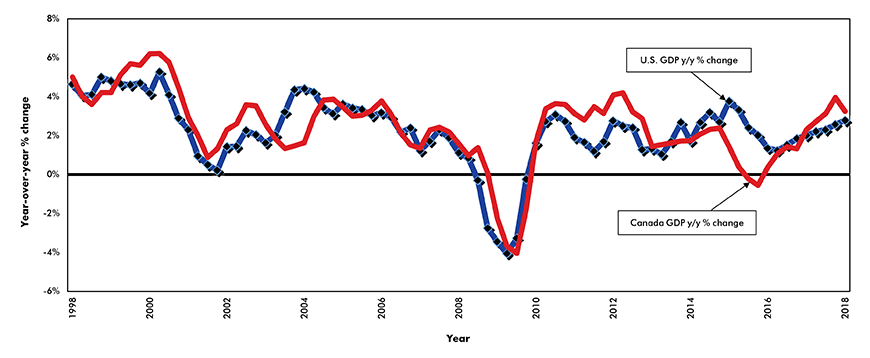Despite the doomsters’ claims of an impending recession due to a breakdown in global trade, the economic outlooks for the world in general, for the United States and indeed for over-taxed Canada, appear quite positive. Perhaps I should add a “for now,” but all three jurisdictions have considerable momentum that should extend well into next year.
Turning first to the global economic outlook, the Organisation for Economic Cooperation and Development (OECD), the International Monetary Fund (IMF) and the World Bank’s just released Global Economic Prospects are relatively upbeat regarding the near-term outlook for the global economy.
Indeed, both the OECD and the IMF have upgraded their 2018 forecasts and expect global growth to remain in the range of 3.7% to 3.9% in 2019. Looking beyond 2019, the IMF and the OECD both expect that the good times cannot last indefinitely and they expect that the “positive momentum will eventually slow.”
While wage and price inflation are projected to creep higher over the near term, the OECD expects its member-nations’ unemployment rate will fall to a 39-year low of 5.1% in 2019. It perhaps goes without saying that neither institution is expecting the global economy to collapse in the near term.
Against this background of strong global growth, the U.S. economy is performing considerably better than most forecasters projected a year ago. Fuelled by the combination of still low interest rates, corporate and personal income tax cuts introduced at the beginning of the year and a strengthening of both business and consumer confidence, the U.S. economy appears poised to post its strongest annual gain since 2005.
Current indicators which reinforce this prospect include the latest National Federation of Independent Business’ Small Business Optimism Index which increased by 3 points to 107.8 in May, its second highest reading in its 45-year history.
Also, the Federal Reserve’s latest Beige Book reported that the improvement in economic activity was widespread across all twelve Federal Reserve districts. Two indicators suggest that our southern neighbour’s economy is growing above potential heading into the second half of the year. First, industrial capacity utilization is at a four-year high while an uninterrupted increase in establishment employment over the past ten years caused the unemployment rate to drop to a forty-year low of 3.7% in May and job openings now exceed the number of unemployed. Further evidence of this above-potential pattern of growth is the fact that the core inflation rate (excluding food and energy) increased by 2.3% in May, a six-year high.
So what about Canada? Well, despite the blizzard of apocalyptic news about an impending global trade war, most analysts expect the Canadian economy to grow at or close to its potential (estimated by the Bank of Canada to be 2%) over the next twelve to eighteen months.
This generally upbeat outlook is reinforced both by the OECD’s Canada forecast which calls for growth of over 2% from mid-2018 on and by the just-released Bank of Canada Business Outlook Survey (BOS). It reported that “despite some expectations of a moderation in the pace of sales growth, firms’ sales outlooks remain robust”.
Firms’ investment intentions retreated slightly but were still quite “buoyant” and the Business Outlook Survey indicator moved to near record levels in the second quarter. Consistent with the steady decline in Canada’s unemployment rate to an eleven-year low of 5.8% and evidence of increasing capacity utilization, the BOS reported that inflationary expectations reached a six-year high in the second quarter. The generally very positive tone of this survey was tempered somewhat by the fact that it was conducted prior to imposition of the U.S. tariffs on steel and aluminum.
Based on our experience, there is always something which is threatening, overshadowing or at least clouding the near-term outlook for the economy. This time, it’s a potential trade war.
Given that we are the United States’ largest foreign customer and vice-versa, we don’t think that President Trump is going to build a wall along the Canada-U.S. border. The close relationship between the two economies is clearly illustrated in the chart.
Also, while the tariffs on our steel and aluminum exports will hurt us slightly, the general consensus of economists is that they will have a limited impact on the overall level of economic activity since our total exports of steel and aluminum account for just 5% of our total U.S. exports. While the near-term impact of this trade spat is limited, the failure to resolve this issue in the short term will, by creating a lingering climate of uncertainty, cause export-dependent firms to shelve expansion plans and postpone hiring additional staff.
Year-over-year change in Gross Domestic Product (GDP) – Canada vs the United States

Chart: ConstructConnect — CanaData.










Recent Comments
comments for this post are closed